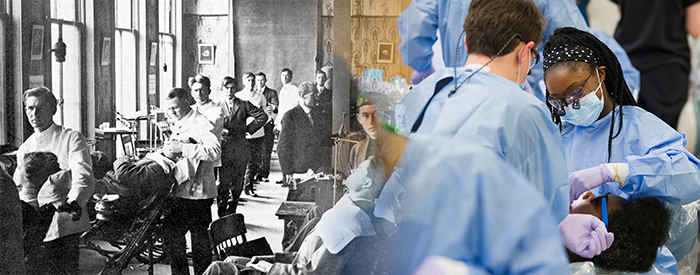More than just a building

In October 2017, hundreds of Texas A&M College of Dentistry students, faculty, staff and friends gathered to celebrate a milestone in the school’s history: a construction site dedication for the college’s nine-story, 157,756 square-foot Clinic and Education Building, which, upon its completion in fall 2019, will be the first new freestanding facility for the school since 1950. While the advancements at the clinical location will be progressive in terms of patient care delivery and first rate with regard to technology, the impact of the school on the North Texas community traces back more than 100 years.
When classes started in the fall 1905 at what was then State Dental College, it marked the culmination of more than a year of work to found the school. At the time, less than half of practicing dentists had a college education, much less a dental degree, and David E. Morrow, D.D.S., the school’s founder and first dean, sought to change that. His ultimate goal: Start an educational program for aspiring dentists.
At the time, support for a dental school in Dallas was lackluster. A majority of Texas dentists didn’t see a need for a dental school, pointing out the merits of apprenticeship, the option to send students to out-of-state schools and the concern about creating more professional competition. But Morrow forged ahead anyway. He even explored another potential site in Houston, with little reception from the local dental community. Oddly enough, after his visit to garner support for a Houston school, a group of Houston area dentists decided to apply for a charter to establish a school there. The turn of events in Houston only emboldened Morrow to establish a Dallas dental school. With the help of another St. Louis dentist, they applied for a charter and raised the $4,500 from private investors in order to open the college.
The first two Texas dental schools opened within one day of each other: Oct. 2, Texas Dental College, which later became the UT School of Dentistry at Houston, and Oct. 3, State Dental College, which later became Baylor College of Dentistry and eventually Texas A&M College of Dentistry.
That original mission of providing an education for up-and-coming dentists continues today and has developed in complexity over time. As student numbers have fluctuated over the decades from the first class of four graduates to a current class size of approximately 100 students, the advancement of patient care has gained increasing focus in the college curriculum.
Today, the College of Dentistry maintains more than 100,000 patient visits a year, making it the single largest provider of oral health care in North Texas. Students treat patients in campus clinics as well as through partner facilities in the college’s community-based training program. In the dental school’s public health sciences arena, students learn in settings such as community clinics, health fairs, and preceptorships with practicing dentists. Since 2000 alone, students have learned from more than 803,000 patient experiences.
“It’s these clinical experiences that equip students to return to their communities to provide much-needed care,” says Dr. Lawrence Wolinsky, dean of the College of Dentistry.
Excellence in dental education continues to evolve, as college administrators steadily move the college to a vertical, rather than horizontal curriculum, integrating patient care even earlier in the educational process, instead of just the last two years. In late 2019, this effort will be enhanced with the addition of the Clinic and Education Building, designed to foster group practice settings. Dental and dental hygiene students, along with their faculty supervisors, will work in “pods” that resemble group practices, allowing dental specialists to come to the patient, rather than requiring that the patient visit multiple clinics in the same building.
“The College of Dentistry has long prided itself on its ability to educate the next generation of dental professionals while caring for the oral health of so many North Texas residents,” Wolinsky said. “With this building expansion, that service to the community will only increase.”